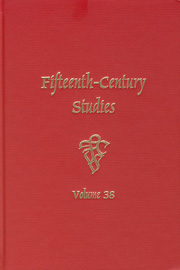Book contents
- Frontmatter
- Contents
- A Monastic Reformation of Domestic Space: Richard Whitford's Werke for Housholders
- Two Cultural Perspectives on the Battle of Lippa, Transylvania, 1551: Whose Victory Is It?
- Interpreting Sir Gawain and the Green Knight: Translation and Manipulation of Audience Expectations
- The Dry Tree Legend in Medieval Literature
- The Book of the Duke and Emperor: A New Edition and Interpretations within the Manuscript Context of MS. Manchester, Chetham's Library 8009 (Mun. A.6.31)
- Margery Kempe and the Spectatorship of Medieval Drama
- Wessel Gansfort, John Mombaer, and Medieval Technologies of the Self: Affective Meditation in a Fifteenth-Century Emotional Community
- Discerning Voices in the Trial of Joan of Arc and The Book of Margery Kempe
- Book Reviews
The Dry Tree Legend in Medieval Literature
Published online by Cambridge University Press: 05 September 2013
- Frontmatter
- Contents
- A Monastic Reformation of Domestic Space: Richard Whitford's Werke for Housholders
- Two Cultural Perspectives on the Battle of Lippa, Transylvania, 1551: Whose Victory Is It?
- Interpreting Sir Gawain and the Green Knight: Translation and Manipulation of Audience Expectations
- The Dry Tree Legend in Medieval Literature
- The Book of the Duke and Emperor: A New Edition and Interpretations within the Manuscript Context of MS. Manchester, Chetham's Library 8009 (Mun. A.6.31)
- Margery Kempe and the Spectatorship of Medieval Drama
- Wessel Gansfort, John Mombaer, and Medieval Technologies of the Self: Affective Meditation in a Fifteenth-Century Emotional Community
- Discerning Voices in the Trial of Joan of Arc and The Book of Margery Kempe
- Book Reviews
Summary
In one early fifteenth-century manuscript of Piers Plowman, Cotton Caligula A XI, housed in the British Library, the following exchange opens passus 16 of the poem. The Dreamer thanks Anima for his instruction on salvation, ecclesiastical history, and contemporary problems within the institutional church,
Now fayr falle ʒou q[uoth] I tho. for ʒour faire shewyng for haukyns loue the actyf man. eu[er] I shal ʒou louye ac ʒit I am in a were. what charite is to mene
to which Anima replies, “hit is a ful drye tree … treuly to telle.” Textual error, however, has crept into the copy here: Langland's Tree of Charity is supposed to be a full trie tree — meaning fine or excellent — and indeed the Cotton Caligula text goes on to elaborate upon the leaves and blossoms of this marvelous wood. While we may dismiss such occurrences of textual error as proof of scribal incompetence, such a point of view does not alter the fact that Cotton's textual reading possesses sense as written, because its “ful drye tree” calls to mind the Dry Tree of medieval legend. But the background and significance of this fabulous tree, even though familiar in the Middle Ages since the thirteenth century when the Tree became a stock reference in travelogues and romances, are barely known in the twenty-first century outside the confines of art history.
- Type
- Chapter
- Information
- Fifteenth-Century Studies 38 , pp. 65 - 96Publisher: Boydell & BrewerPrint publication year: 2013

